Air conditioner Hyundai Ioniq Hybrid 2018 Owner's Manual
[x] Cancel search | Manufacturer: HYUNDAI, Model Year: 2018, Model line: Ioniq Hybrid, Model: Hyundai Ioniq Hybrid 2018Pages: 642, PDF Size: 16.33 MB
Page 39 of 642
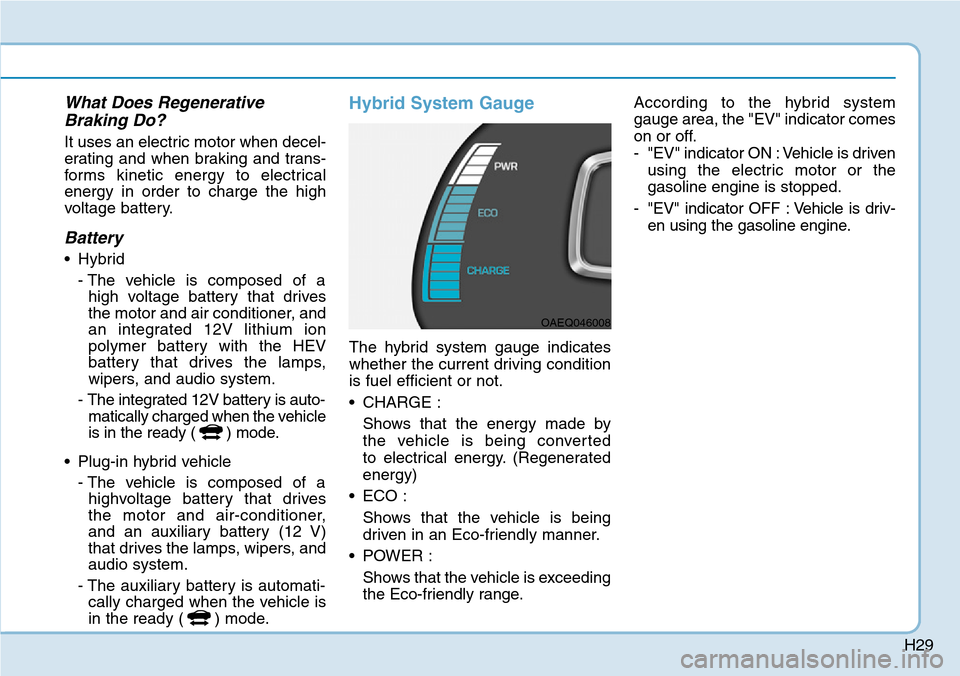
H29
What Does Regenerative
Braking Do?
It uses an electric motor when decel-
erating and when braking and trans-
forms kinetic energy to electrical
energy in order to charge the high
voltage battery.
Battery
• Hybrid
- The vehicle is composed of a
high voltage battery that drives
the motor and air conditioner, and
an integrated 12V lithium ion
polymer battery with the HEV
battery that drives the lamps,
wipers, and audio system.
- The integrated 12V battery is auto-
matically charged when the vehicle
is in the ready ( ) mode.
• Plug-in hybrid vehicle
- The vehicle is composed of a
highvoltage battery that drives
the motor and air-conditioner,
and an auxiliary battery (12 V)
that drives the lamps, wipers, and
audio system.
- The auxiliary battery is automati-
cally charged when the vehicle is
in the ready ( ) mode.
Hybrid System Gauge
The hybrid system gauge indicates
whether the current driving condition
is fuel efficient or not.
• CHARGE :
Shows that the energy made by
the vehicle is being converted
to electrical energy. (Regenerated
energy)
• ECO :
Shows that the vehicle is being
driven in an Eco-friendly manner.
• POWER :
Shows that the vehicle is exceeding
the Eco-friendly range.According to the hybrid system
gauge area, the "EV" indicator comes
on or off.
- "EV" indicator ON : Vehicle is driven
using the electric motor or the
gasoline engine is stopped.
- "EV" indicator OFF : Vehicle is driv-
en using the gasoline engine.
OAEQ046008
Page 299 of 642
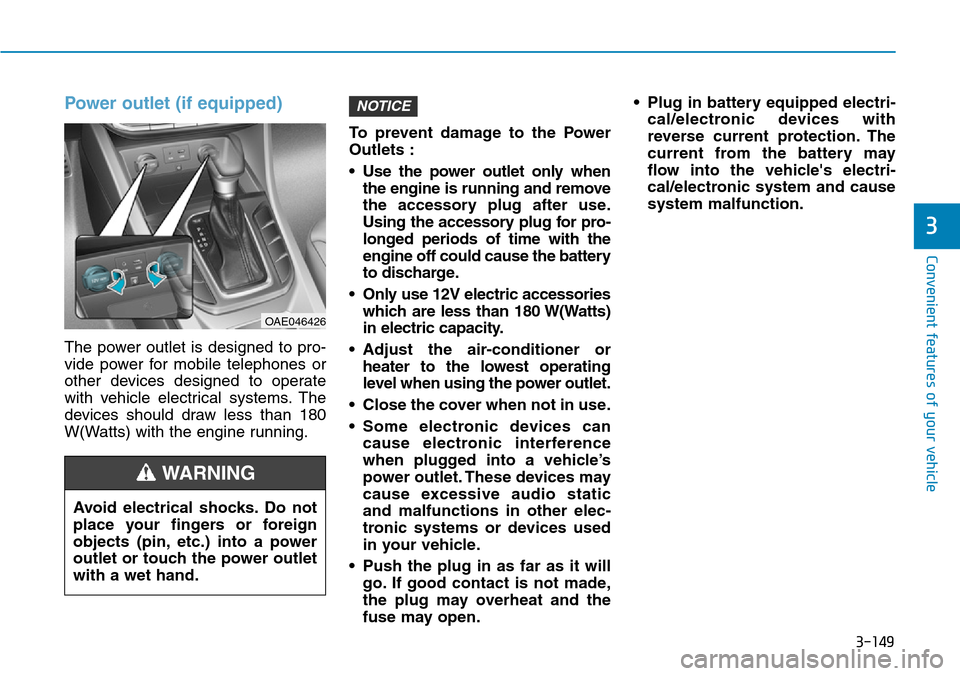
3-149
Convenient features of your vehicle
3
Power outlet (if equipped)
The power outlet is designed to pro-
vide power for mobile telephones or
other devices designed to operate
with vehicle electrical systems. The
devices should draw less than 180
W(Watts) with the engine running.To prevent damage to the Power
Outlets :
• Use the power outlet only when
the engine is running and remove
the accessory plug after use.
Using the accessory plug for pro-
longed periods of time with the
engine off could cause the battery
to discharge.
• Only use 12V electric accessories
which are less than 180 W(Watts)
in electric capacity.
• Adjust the air-conditioner or
heater to the lowest operating
level when using the power outlet.
• Close the cover when not in use.
• Some electronic devices can
cause electronic interference
when plugged into a vehicle’s
power outlet. These devices may
cause excessive audio static
and malfunctions in other elec-
tronic systems or devices used
in your vehicle.
• Push the plug in as far as it will
go. If good contact is not made,
the plug may overheat and the
fuse may open.• Plug in battery equipped electri-
cal/electronic devices with
reverse current protection. The
current from the battery may
flow into the vehicle's electri-
cal/electronic system and cause
system malfunction.
NOTICE
OAE046426
Avoid electrical shocks. Do not
place your fingers or foreign
objects (pin, etc.) into a power
outlet or touch the power outlet
with a wet hand.
WARNING
Page 459 of 642
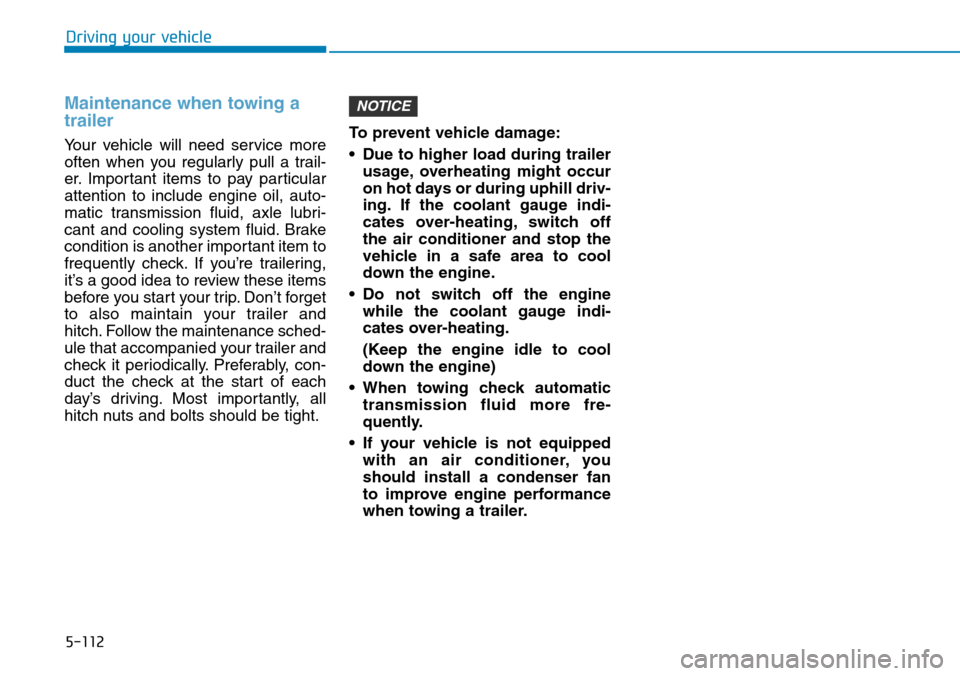
5-112
Maintenance when towing a
trailer
Your vehicle will need service more
often when you regularly pull a trail-
er. Important items to pay particular
attention to include engine oil, auto-
matic transmission fluid, axle lubri-
cant and cooling system fluid. Brake
condition is another important item to
frequently check. If you’re trailering,
it’s a good idea to review these items
before you start your trip. Don’t forget
to also maintain your trailer and
hitch. Follow the maintenance sched-
ule that accompanied your trailer and
check it periodically. Preferably, con-
duct the check at the start of each
day’s driving. Most importantly, all
hitch nuts and bolts should be tight.To prevent vehicle damage:
• Due to higher load during trailer
usage, overheating might occur
on hot days or during uphill driv-
ing. If the coolant gauge indi-
cates over-heating, switch off
the air conditioner and stop the
vehicle in a safe area to cool
down the engine.
• Do not switch off the engine
while the coolant gauge indi-
cates over-heating.
(Keep the engine idle to cool
down the engine)
• When towing check automatic
transmission fluid more fre-
quently.
• If your vehicle is not equipped
with an air conditioner, you
should install a condenser fan
to improve engine performance
when towing a trailer.
NOTICE
Driving your vehicle
Page 472 of 642
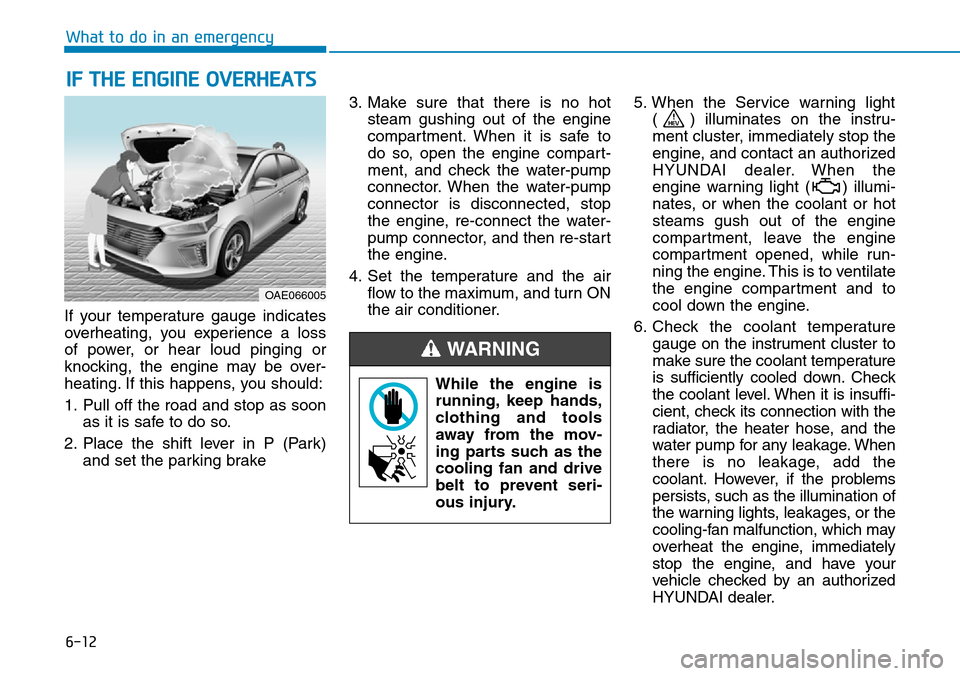
6-12
What to do in an emergency
If your temperature gauge indicates
overheating, you experience a loss
of power, or hear loud pinging or
knocking, the engine may be over-
heating. If this happens, you should:
1. Pull off the road and stop as soon
as it is safe to do so.
2. Place the shift lever in P (Park)
and set the parking brake3. Make sure that there is no hot
steam gushing out of the engine
compartment. When it is safe to
do so, open the engine compart-
ment, and check the water-pump
connector. When the water-pump
connector is disconnected, stop
the engine, re-connect the water-
pump connector, and then re-start
the engine.
4. Set the temperature and the air
flow to the maximum, and turn ON
the air conditioner.5. When the Service warning light
( ) illuminates on the instru-
ment cluster, immediately stop the
engine, and contact an authorized
HYUNDAI dealer. When the
engine warning light ( ) illumi-
nates, or when the coolant or hot
steams gush out of the engine
compartment, leave the engine
compartment opened, while run-
ning the engine. This is to ventilate
the engine compartment and to
cool down the engine.
6. Check the coolant temperature
gauge on the instrument cluster to
make sure the coolant temperature
is sufficiently cooled down. Check
the coolant level. When it is insuffi-
cient, check its connection with the
radiator, the heater hose, and the
water pump for any leakage. When
there is no leakage, add the
coolant. However, if the problems
persists, such as the illumination of
the warning lights, leakages, or the
cooling-fan malfunction, which may
overheat the engine, immediately
stop the engine, and have your
vehicle checked by an authorized
HYUNDAI dealer.
IF THE ENGINE OVERHEATS
While the engine is
running, keep hands,
clothing and tools
away from the mov-
ing parts such as the
cooling fan and drive
belt to prevent seri-
ous injury.
WARNING
OAE066005
Page 519 of 642
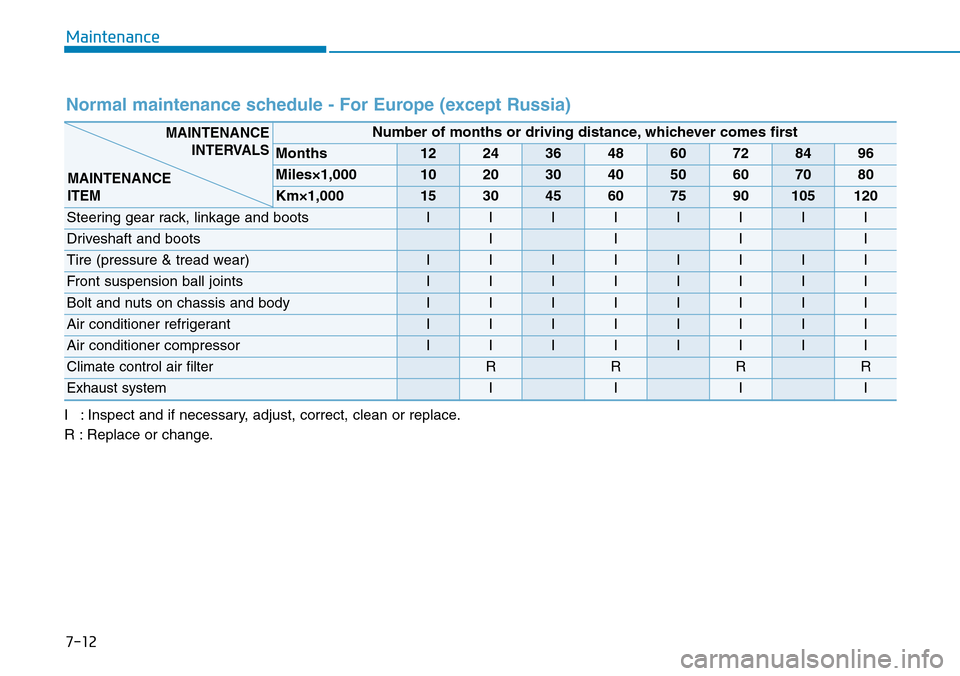
7-12
Maintenance
Normal maintenance schedule - For Europe (except Russia)
I : Inspect and if necessary, adjust, correct, clean or replace.
R : Replace or change.
Number of months or driving distance, whichever comes first
Months1224364860728496
Miles×1,0001020304050607080
Km×1,000153045607590105120
Steering gear rack, linkage and bootsIIIIIIII
Driveshaft and bootsIIII
Tire (pressure & tread wear) IIIIIIII
Front suspension ball jointsIIIIIIII
Bolt and nuts on chassis and bodyIIIIIIII
Air conditioner refrigerant IIIIIIII
Air conditioner compressorIIIIIIII
Climate control air filterRRRR
Exhaust systemIIII
MAINTENANCE
INTERVALS
MAINTENANCE
ITEM
Page 525 of 642
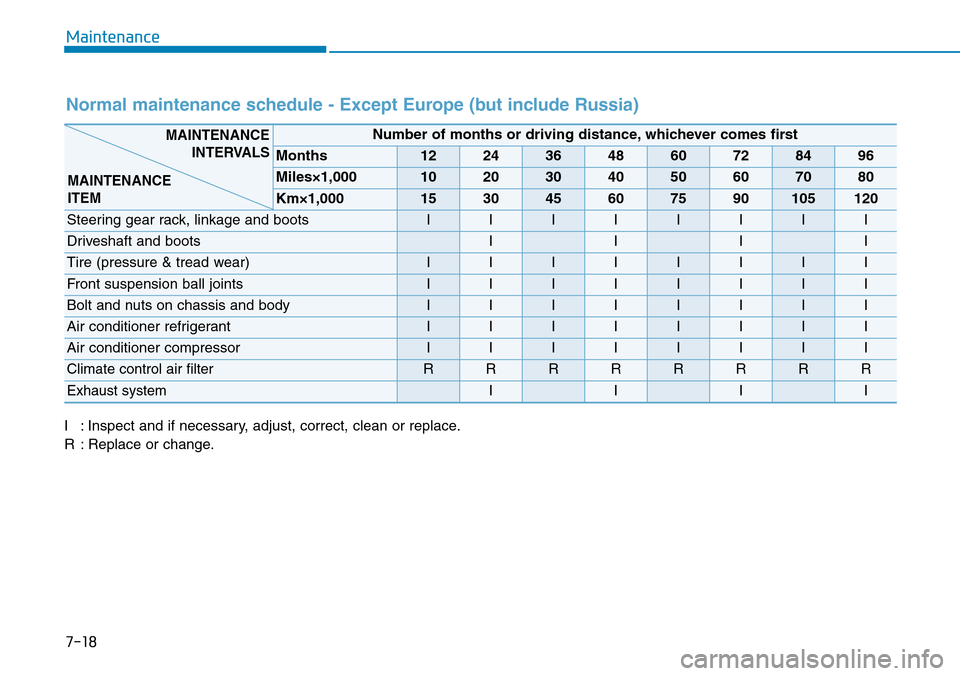
7-18
Maintenance
Normal maintenance schedule - Except Europe (but include Russia)
Number of months or driving distance, whichever comes first
Months1224364860728496
Miles×1,0001020304050607080
Km×1,000153045607590105120
Steering gear rack, linkage and bootsIIIIIIII
Driveshaft and bootsIIII
Tire (pressure & tread wear) IIIIIIII
Front suspension ball jointsIIIIIIII
Bolt and nuts on chassis and bodyIIIIIIII
Air conditioner refrigerant IIIIIIII
Air conditioner compressorIIIIIIII
Climate control air filterRRRRRRRR
Exhaust systemIIII
MAINTENANCE
INTERVALS
MAINTENANCE
ITEM
I : Inspect and if necessary, adjust, correct, clean or replace.
R : Replace or change.
Page 567 of 642
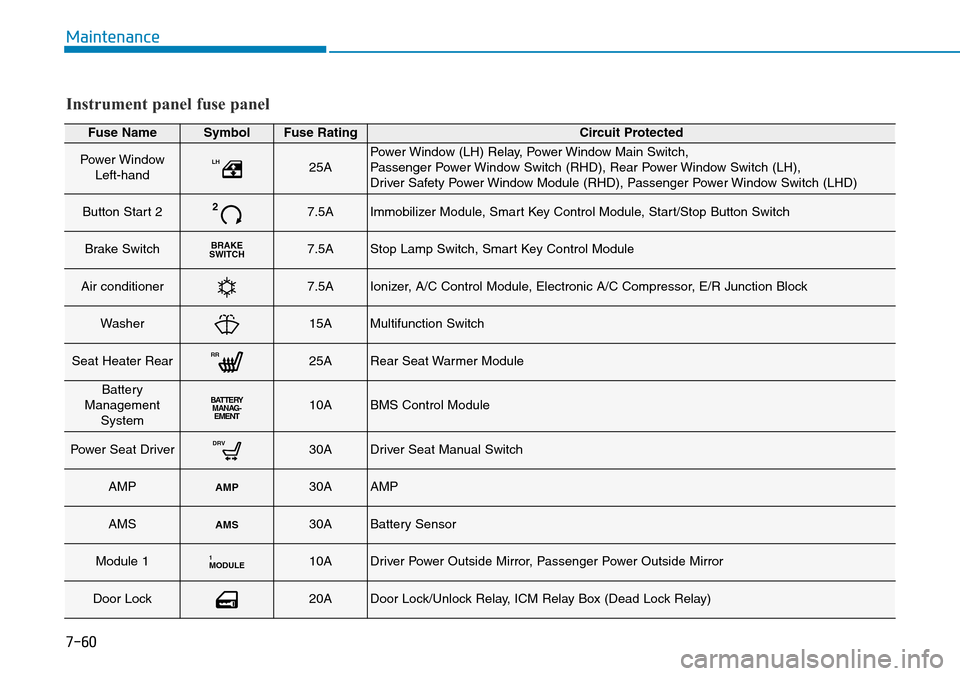
7-60
Maintenance
Fuse NameSymbolFuse RatingCircuit Protected
Power Window
Left-handLH25APower Window (LH) Relay, Power Window Main Switch,
Passenger Power Window Switch (RHD), Rear Power Window Switch (LH),
Driver Safety Power Window Module (RHD), Passenger Power Window Switch (LHD)
Button Start 227.5AImmobilizer Module, Smart Key Control Module, Start/Stop Button Switch
Brake SwitchBRAKE
SWITCH7.5AStop Lamp Switch, Smart Key Control Module
Air conditioner7.5AIonizer, A/C Control Module, Electronic A/C Compressor, E/R Junction Block
Washer15AMultifunction Switch
Seat Heater RearRR25ARear Seat Warmer Module
Battery
Management
SystemBATTERYMANAG-
EMENT10ABMS Control Module
Power Seat DriverDRV30ADriver Seat Manual Switch
AMPAMP30AAMP
AMSAMS30ABattery Sensor
Module 1MODULE110ADriver Power Outside Mirror, Passenger Power Outside Mirror
Door Lock20ADoor Lock/Unlock Relay, ICM Relay Box (Dead Lock Relay)
Instrument panel fuse panel
Page 603 of 642
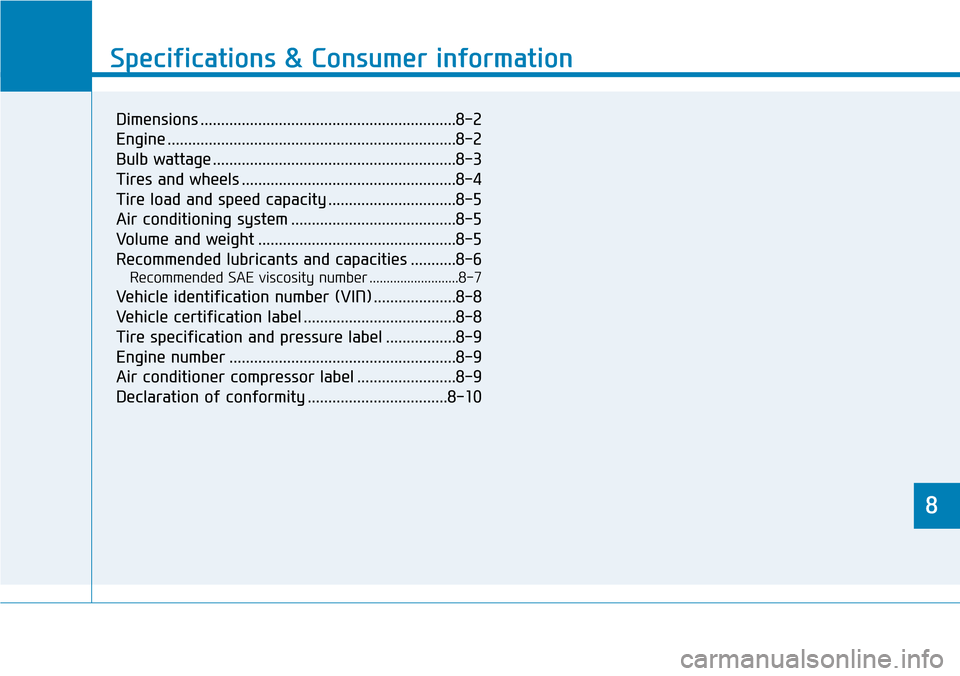
8
Specifications & Consumer information
8
Specifications & Consumer information
8
Dimensions ..............................................................8-2
Engine ......................................................................8-2
Bulb wattage ...........................................................8-3
Tires and wheels ....................................................8-4
Tire load and speed capacity ...............................8-5
Air conditioning system ........................................8-5
Volume and weight ................................................8-5
Recommended lubricants and capacities ...........8-6
Recommended SAE viscosity number ..........................8-7
Vehicle identification number (VIN) ....................8-8
Vehicle certification label .....................................8-8
Tire specification and pressure label .................8-9
Engine number .......................................................8-9
Air conditioner compressor label ........................8-9
Declaration of conformity ..................................8-10
Page 611 of 642
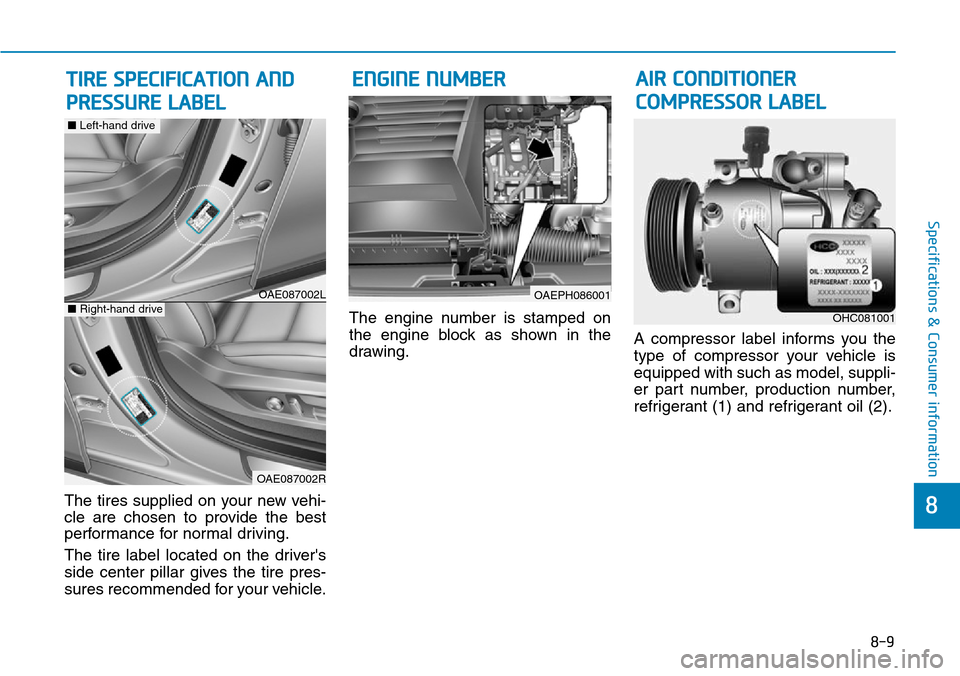
8-9
8
Specifications & Consumer information
The tires supplied on your new vehi-
cle are chosen to provide the best
performance for normal driving.
The tire label located on the driver's
side center pillar gives the tire pres-
sures recommended for your vehicle.The engine number is stamped on
the engine block as shown in the
drawing.A compressor label informs you the
type of compressor your vehicle is
equipped with such as model, suppli-
er part number, production number,
refrigerant (1) and refrigerant oil (2).
TIRE SPECIFICATION AND
PRESSURE LABELENGINE NUMBER
OHC081001
AIR CONDITIONER
COMPRESSOR LABEL
OAEPH086001OAE087002L
OAE087002R
■Right-hand drive
■Left-hand drive
Page 631 of 642
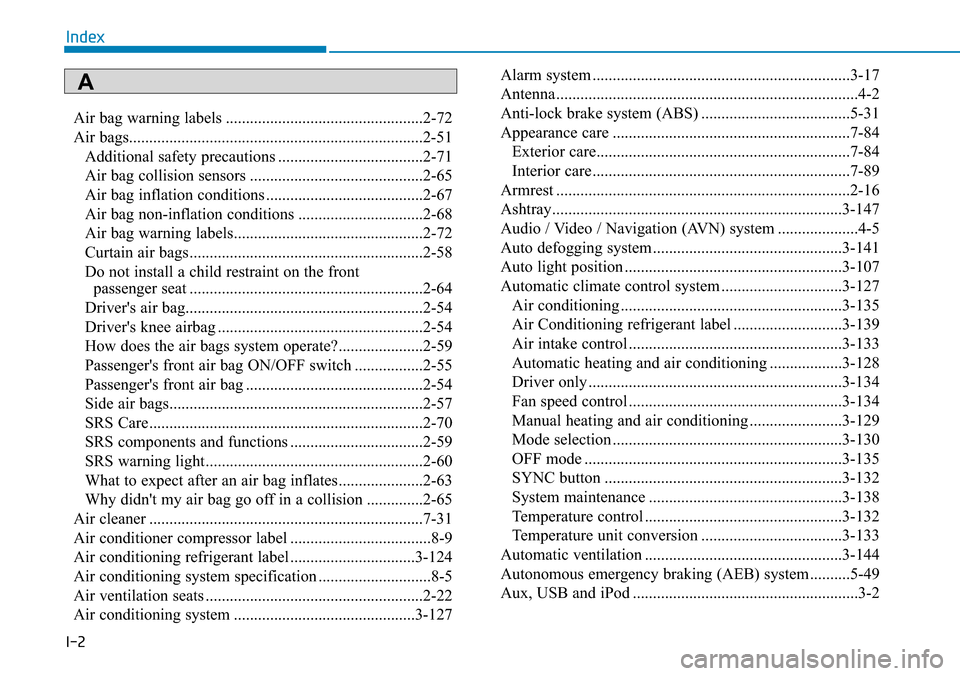
I-2
Air bag warning labels .................................................2-72
Air bags.........................................................................2-51
Additional safety precautions ....................................2-71
Air bag collision sensors ...........................................2-65
Air bag inflation conditions .......................................2-67
Air bag non-inflation conditions ...............................2-68
Air bag warning labels...............................................2-72
Curtain air bags..........................................................2-58
Do not install a child restraint on the front
passenger seat ..........................................................2-64
Driver's air bag...........................................................2-54
Driver's knee airbag ...................................................2-54
How does the air bags system operate?.....................2-59
Passenger's front air bag ON/OFF switch .................2-55
Passenger's front air bag ............................................2-54
Side air bags...............................................................2-57
SRS Care....................................................................2-70
SRS components and functions .................................2-59
SRS warning light......................................................2-60
What to expect after an air bag inflates.....................2-63
Why didn't my air bag go off in a collision ..............2-65
Air cleaner ....................................................................7-31
Air conditioner compressor label ...................................8-9
Air conditioning refrigerant label ...............................3-124
Air conditioning system specification ............................8-5
Air ventilation seats ......................................................2-22
Air conditioning system .............................................3-127Alarm system ................................................................3-17
Antenna ...........................................................................4-2
Anti-lock brake system (ABS) .....................................5-31
Appearance care ...........................................................7-84
Exterior care...............................................................7-84
Interior care................................................................7-89
Armrest .........................................................................2-16
Ashtray........................................................................3-147
Audio / Video / Navigation (AVN) system ....................4-5
Auto defogging system ...............................................3-141
Auto light position ......................................................3-107
Automatic climate control system ..............................3-127
Air conditioning .......................................................3-135
Air Conditioning refrigerant label ...........................3-139
Air intake control .....................................................3-133
Automatic heating and air conditioning ..................3-128
Driver only ...............................................................3-134
Fan speed control .....................................................3-134
Manual heating and air conditioning .......................3-129
Mode selection .........................................................3-130
OFF mode ................................................................3-135
SYNC button ...........................................................3-132
System maintenance ................................................3-138
Temperature control .................................................3-132
Temperature unit conversion ...................................3-133
Automatic ventilation .................................................3-144
Autonomous emergency braking (AEB) system ..........5-49
Aux, USB and iPod ........................................................3-2
Index
A